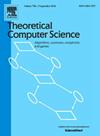Algorithms for Shortest Path Tour Problem
IF 1
4区 计算机科学
Q3 COMPUTER SCIENCE, THEORY & METHODS
引用次数: 0
Abstract
Carpooling route planning becomes an important problem with the growth of low-carbon traffic systems. When each passenger has multiple potential pick-up/drop-off locations, the problem will be more challenging. In the paper, we discussed a simplified carpooling route planning problem, namely the Shortest Path Tour Problem (SPTP), whose aim is to find a single-origin single-destination shortest path through an ordered sequence of disjoint node subsets. We propose Stage Dijkstra and Global Dijkstra algorithms to find the optimal shortest path, with the time complexity of and respectively, where l represents the number of node subsets. To the best of our knowledge, is the best time complexity of the exact algorithms for SPTP. Besides, the Stage Dijkstra and Global Dijkstra algorithms both have the linear space complexity, which is highly suitable for resource-constrained environments. Experiments conducted on large-scale road networks and synthetic datasets demonstrate the effectiveness and efficiency of our proposed algorithms in terms of running time and memory consumption.
最短路径漫游问题的算法
随着低碳交通系统的发展,拼车路线规划成为一个重要的问题。当每个乘客都有多个可能的上下车地点时,问题将更具挑战性。本文讨论了一个简化的拼车路径规划问题,即最短路径漫游问题(SPTP),其目的是通过不相交的节点子集的有序序列找到一条单起点单目的地的最短路径。我们提出了Stage Dijkstra和Global Dijkstra算法来寻找最优最短路径,时间复杂度分别为O(l(n+m)log (n))和O(l(n+m)log (ln)),其中l表示节点子集的数量。据我们所知,O(l(n+m)log (n))是SPTP精确算法的最佳时间复杂度。此外,Stage Dijkstra算法和Global Dijkstra算法都具有线性空间复杂度,非常适合于资源受限的环境。在大规模道路网络和合成数据集上进行的实验证明了我们提出的算法在运行时间和内存消耗方面的有效性和效率。
本文章由计算机程序翻译,如有差异,请以英文原文为准。
求助全文
约1分钟内获得全文
求助全文
来源期刊

Theoretical Computer Science
工程技术-计算机:理论方法
CiteScore
2.60
自引率
18.20%
发文量
471
审稿时长
12.6 months
期刊介绍:
Theoretical Computer Science is mathematical and abstract in spirit, but it derives its motivation from practical and everyday computation. Its aim is to understand the nature of computation and, as a consequence of this understanding, provide more efficient methodologies. All papers introducing or studying mathematical, logic and formal concepts and methods are welcome, provided that their motivation is clearly drawn from the field of computing.
 求助内容:
求助内容: 应助结果提醒方式:
应助结果提醒方式:


